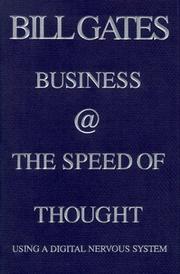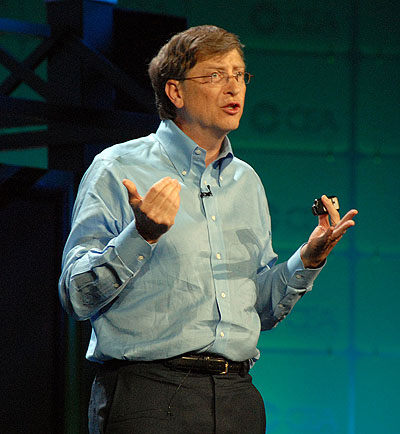“It is sobering to reflect on the extent to which the structure of our business processes has been dictated by the limitations of the file folder.”
-Michael Hammer and James Champy, Reengineering Your Business
Recently, I unearthed a 10 year old book by Bill Gates, Business @ the Speed of Thought and took a bit of time to re-scan that 1999 book. On the first day of 2010, it seems appropriate to study technology trends to help give perspective to the future of the digital revolution.
Far from being an overtly partisan paen to Microsoft, the passion and enthusiam for change reflective both Bill Gates personality and the thinking of that era, shine through.
What is being presented is a prescription for a world, focused primarily on business, where mass adoption of networked computing unleashes a digital, knowledge-based revolution.
In the 1990’s, Information Technology (“IT”) was considered a “necessary evil” in business, being viewed largely as a cost centre, and consigned to report to the CFO with a major focus on cost control. Although we’ve made some progress in the last decade, there is still a huge need to educate all business people on how essential IT is to creating competitive advantage, mitigating risk and enabling new products and services. In essence, IT and the modern business, are inseparably intertwined. He suggests the notion of a “Digital Nervous System” as shorthand for a set of best practices for business to use. Although this short hand hasn’t really caught on, the ideas behind it remain.
And yet, it is easy to dismiss much of this early prosletyzing as impractical dreaming, a fact that the “dot com meltdown” probably exacerbated. So, how much of the 1990’s vision makes sense today?
Somewhat surprisingly, the answer is most of it. While some trends were completely unticipated by Bill Gates, and most of his peers in the 1990’s:
 cloud computing, driven by virtualization, in which vast arrays of commodity computing power is outsourced and interconnected with high bandwidth network connectivity wasn’t considered at all. The 1990’s ethos was company controlled, in house, server farms.
cloud computing, driven by virtualization, in which vast arrays of commodity computing power is outsourced and interconnected with high bandwidth network connectivity wasn’t considered at all. The 1990’s ethos was company controlled, in house, server farms.- social networking and social media weren’t even thought of. Driven by recent research into how ideas can spread and and recent breakthroughs in the science of social networks, coupled with cheap, pervasive and always connected computing, this is a real paradigm shift from the 1990’s world view.
- outsourcing and offshoring, in which large companies access “clouds” of talent and hence are looser federations of people, is perhaps only foreshadowed. The power of individual contractors and smaller businesses has been signficantly enhanced, thus levelling the playing field in our modern digital economy.
many of the predictions and recommendations remain true or have gone from vision to reality:
 Web 2.0 can be viewed as many pre-bubble Web 1.0 concepts finally coming to reality in the fullness of time. Whereas there used to be much talk about “bricks” versus “clicks”, the modern company is fully integrated with the Web as a part of the distribution strategy. Companies that were simply a “web veneer”, like Webvan or Pets.com are gone and long forgotten.
Web 2.0 can be viewed as many pre-bubble Web 1.0 concepts finally coming to reality in the fullness of time. Whereas there used to be much talk about “bricks” versus “clicks”, the modern company is fully integrated with the Web as a part of the distribution strategy. Companies that were simply a “web veneer”, like Webvan or Pets.com are gone and long forgotten.- The Paperless Office, long envisaged as part of the digital revolution, is finally starting to arrive. While some days I personally seem to be unable to keep the paper monster under control, many companies have made great strides. For example, Gore Mutual Insurance Company where I recently joined the Board, has completed a transformation to paperless insurance making Canada’s oldest insurance company one of the first in North America to go paperless.
- Disintermediation, or the death of the middleman, has accelerated recently. It could be argued that only highly differentiated specialist travel agents survive and the plight of the newspapers (when compared to the wildly successful wire services) are two great examples of this prediction coming true.
- Knowledge Based Management Style has been driven to a much more open and collaborative one, largely by the force of the digital revolution. Although exceptions exist, every company needs to encourage the “bad news” to flow up to the top. The days of the hubristic CEO who stifles the “inconvenient truth” or fires the naysayer are surely numbered. When almost every business starts to look like a knowledge business, and information is power, cultural or procedural barriers to real time information flow become a serious competitive disadvantage.
- Social Enterprise is being transformed by the digital revolution, and it would appear that BIll Gates was ahead of the curve in seeing this important trend. While much of government, healthcare and education remain in the 20th Century paradigm, IT has driven a remarkable change, such that the boundaries between for profit, not for profit and government enterprises has blurred signficantly. This transformation is an area of personal interest and enthusiam.
- Customer Centred Business is both enabled by, and made essential, in the digital age. The importance of using technology to understand, serve and delight customers remains a key strategic advantage for businesses. Of course, there remain issues and concerns. Specifically, greater customer profiling, can lead to privacy concerns and we still are seeking the right balance. Furthermore, some first generation customers like call centres, have left businesses with their only interpersonal touchpoints being unpleasant. Anyone who has dealt with a Rogers call centre will immediately respond to an environment where siloed IT systems and nonempowered call centre employees create customer alienation. Competition and continuous technological improvement should resolve this over time.
In summary, much of the 1990’s technological vision was spot on. Obviously, it has taken far longer to bring into practice than people then suggested. However, compared to other societal changes, the march of digital technologies has been ligthening fast.
Although it is less fashionable to be a technology visionary today, I believe we still need to look ahead to our future. There remain many unsolved issues IT and, even more important, there are countless opportunities that future digital technologies will be able to deliver. Business leaders, governments and concerned citizens all need to understand and contribute to shaping a future world that will be both efficient, yet retain a good quality of life for us all. A long term perspective remains important because business investments and decisions have a surprisingly long lifespan.
Thus, the promise of the digital revolution continues, and it will be improved by thinkers who can help us to shape our desired future.
1 Jan 2010
0 CommentsTechnology Visionaries in the 1990’s: A 21st Century Retrospective
Recently, I unearthed a 10 year old book by Bill Gates, Business @ the Speed of Thought and took a bit of time to re-scan that 1999 book. On the first day of 2010, it seems appropriate to study technology trends to help give perspective to the future of the digital revolution.
Far from being an overtly partisan paen to Microsoft, the passion and enthusiam for change reflective both Bill Gates personality and the thinking of that era, shine through.
What is being presented is a prescription for a world, focused primarily on business, where mass adoption of networked computing unleashes a digital, knowledge-based revolution.
In the 1990’s, Information Technology (“IT”) was considered a “necessary evil” in business, being viewed largely as a cost centre, and consigned to report to the CFO with a major focus on cost control. Although we’ve made some progress in the last decade, there is still a huge need to educate all business people on how essential IT is to creating competitive advantage, mitigating risk and enabling new products and services. In essence, IT and the modern business, are inseparably intertwined. He suggests the notion of a “Digital Nervous System” as shorthand for a set of best practices for business to use. Although this short hand hasn’t really caught on, the ideas behind it remain.
And yet, it is easy to dismiss much of this early prosletyzing as impractical dreaming, a fact that the “dot com meltdown” probably exacerbated. So, how much of the 1990’s vision makes sense today?
Somewhat surprisingly, the answer is most of it. While some trends were completely unticipated by Bill Gates, and most of his peers in the 1990’s:
many of the predictions and recommendations remain true or have gone from vision to reality:
In summary, much of the 1990’s technological vision was spot on. Obviously, it has taken far longer to bring into practice than people then suggested. However, compared to other societal changes, the march of digital technologies has been ligthening fast.
Although it is less fashionable to be a technology visionary today, I believe we still need to look ahead to our future. There remain many unsolved issues IT and, even more important, there are countless opportunities that future digital technologies will be able to deliver. Business leaders, governments and concerned citizens all need to understand and contribute to shaping a future world that will be both efficient, yet retain a good quality of life for us all. A long term perspective remains important because business investments and decisions have a surprisingly long lifespan.
Thus, the promise of the digital revolution continues, and it will be improved by thinkers who can help us to shape our desired future.